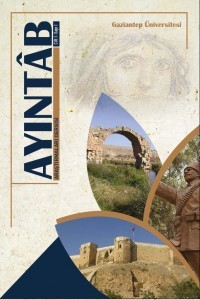
Gaziantep Üniversitesi Ayıntab Araştırmaları Dergisi
Yazarlar: ["Turgay GÖK"]
Konular:-
Anahtar Kelimeler:Mimar Sinan,Zaviyeli Cami,Ters T planlı cami,Gnostik,Gnosiszm,Ayıntab,Osmanlı mimarisi,Türk İslam Sanatı,Su kabağı,Hurma ağacı,Şemsiye tonoz,Yelpaze tonoz,Bursa tipi plan,Zaviye,Tekke,Ribat,Cem evi,Tevhidhâne,Çilehane,Palmet,Yedi kollu şamdan,Mişkat,Mişkan,16. Yüzyıl
Özet: Sheikh Fethullah Zaviyeli-Mosque, located on Kepenek Street in the Şahinbey district of Gaziantep. It had built during Mimar Sinan was Chief Architect period. Because of this, there is a possibility that Sheikh Fethullah Zaviyeli-Mosque maybe was planned by Mimar Sinan and Christian architect "Mi'mâr Rûmî Naṣânî". So an exciting discovery as if it is the first known Mimar Sinan architectural monument in Gaziantep. In our studies, we have evaluated the symbolic reflections of an ancient culture, which we can determine on the Sheikh Fethullah Zaviyeli-Mosque plan, structural elements, decoration, design and the general composition of the building. In this context, the old religious books have expressed Sheikh Fethullah Zaviyeli-Mosque as the first building for worshipping and the first temple which contains some symbol in his structure, giving us that the structure has a supra-religious mission. The symbolism of the building is the work of an esoteric tradition that has survived from the pre-Islamic period. This tradition is an esoteric school that we can follow as Egyptian Hermezim, Christian Gnosistzm, and Islamic Sufism. It is also important that the owner's kufic writing style and the "Ya Hak" of the supreme creator are engraved on the plan of the building, as it is the first inscription found on it. The “gourd” motive seen in the building decoration we have determined revealed its origin and brought it to the literature. The type of Sheikh Fethullah Zaviyeli-Mosque plans to originate from the Mesopotamian city of Eridu as "Temple XVI", in the Middle Byzantine Period as a "closed Greek cross plan", and in the Early Ottoman Period. We can see the "T plan" in temple architecture in every period. The zaviyeli-mosque, which is similar to the monastic structures on many grounds such as location, functionality, creed, and so on shows the continuity of the culture in Anatolia. The zaviye structure, the early example of which can be seen in the village of Onar, Malatya, is also an important example for understanding today's cemevi culture.